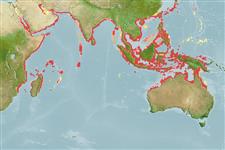Environment: milieu / Zona climática / intervalo de profundidade / distribution range
Ecologia
marinhas; Água doce; estuarina demersal; anádromo (Ref. 51243); intervalo de profundidade 15 - 20 m (Ref. 11790). Tropical; 31°N - 23°S, 33°E - 149°E
Indo-West Pacific: Red Sea and Persian Gulf, then off the west coast of India and Sri Lanka, eastward through the Malay Peninsula and Archipelago to China and northern Australia. Recorded from the mouth of Vivany River in Madagascar (Ref. 6805).
Tamanho / Peso / Idade
Maturidade: Lm ? range ? - ? cm
Max length : 38.0 cm TL macho/indeterminado; (Ref. 116549); common length : 12.0 cm TL macho/indeterminado; (Ref. 3505); peso máx. publicado: 600.00 g (Ref. 116549)
Inhabits shallow sand and mud bottoms in coastal waters. Enters brackish waters (Ref. 6805). Reported to enter fresh waters (Ref. 4833). Feeds mainly on bottom-dwelling invertebrates, especially small crustaceans (Ref. 30573). Marketed fresh, frozen and dried salted.
Ciclo de vida ou comportamento de acasalamento
Maturidade | Reprodução | Desova | Ovos | Fecundidade | Larvas
Munroe, T.A., 2001. Soleidae. Soles. p. 3878-3889. In K.E. Carpenter and V. Niem (eds.) FAO species identification guide for fishery purposes. The living marine resources of the Western Central Pacific. Vol. 6. Bony fishes part 4 (Labridae to Latimeriidae), estuarine crocodiles. FAO, Rome. (Ref. 9893)
Status na Lista Vermelha da UICN (Ref. 130435: Version 2025-1)
Ameaça para os humanos
Harmless
Uso pelos humanos
Pescarias: espécies comerciais
Ferramentas
Relatórios especiais
Baixar XML
Fontes da internet
Estimates based on models
Preferred temperature (Ref.
123201): 25.6 - 29.2, mean 28.5 °C (based on 2132 cells).
Índice de diversidade filogenética (Ref.
82804): PD
50 = 0.5000 [Uniqueness, from 0.5 = low to 2.0 = high].
Bayesian length-weight: a=0.00851 (0.00530 - 0.01367), b=3.03 (2.90 - 3.16), in cm total length, based on LWR estimates for this species & (Sub)family-body (Ref.
93245).
Nível Trófico (Ref.
69278): 4.6 ±0.09 se; based on food items.
Generation time: 5.5 ( na - na) years. Estimated as median ln(3)/K based on 1
growth studies.
Resiliência (Ref.
120179): médio(a), tempo mínimo de duplicação da população 1,4 - 4,4 anos (Preliminary K or Fecundity.).
Fishing Vulnerability (Ref.
59153): Moderate vulnerability (40 of 100).
🛈
Nutrients (Ref.
124155): Calcium = 289 [65, 699] mg/100g; Iron = 0.988 [0.396, 2.560] mg/100g; Protein = 18 [16, 20] %; Omega3 = 0.104 [0.046, 0.211] g/100g; Selenium = 39.5 [18.1, 86.4] μg/100g; VitaminA = 16.4 [5.2, 51.5] μg/100g; Zinc = 1.47 [0.68, 2.96] mg/100g (wet weight);
